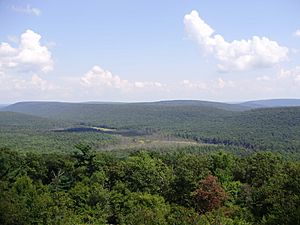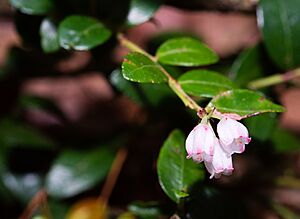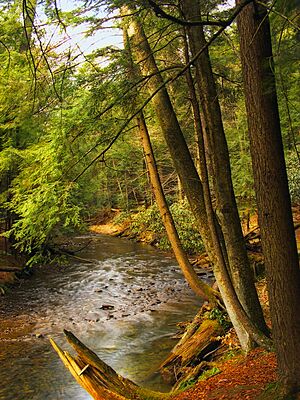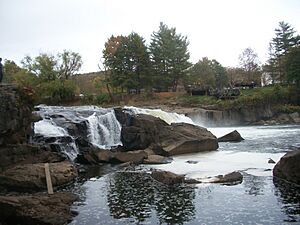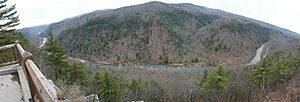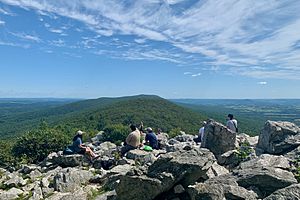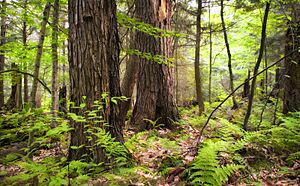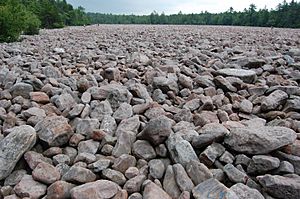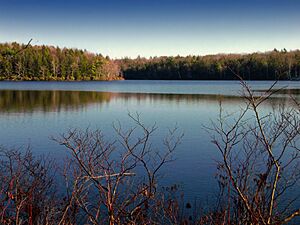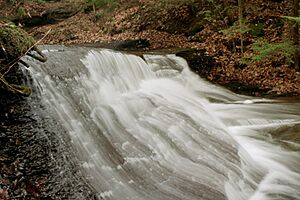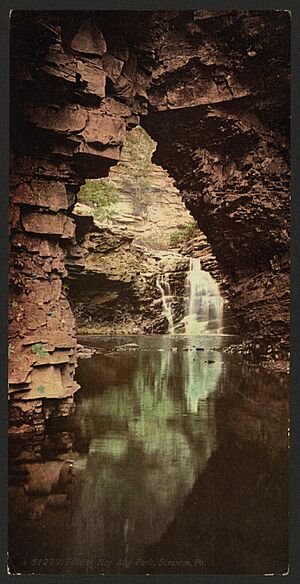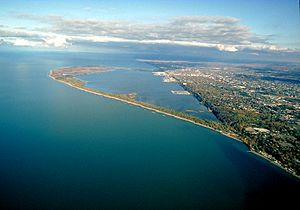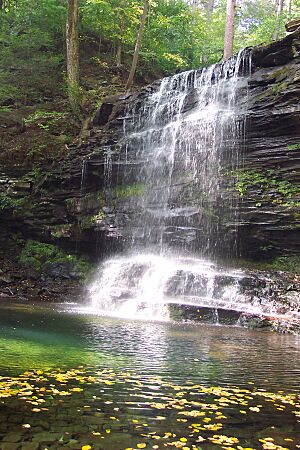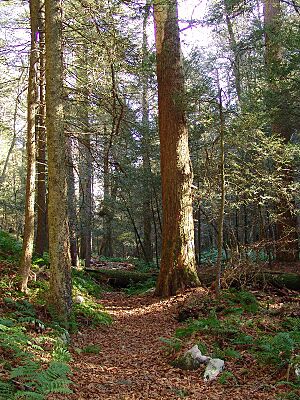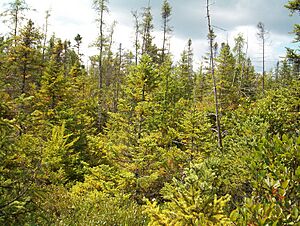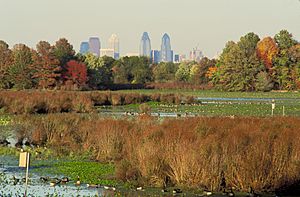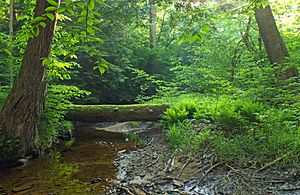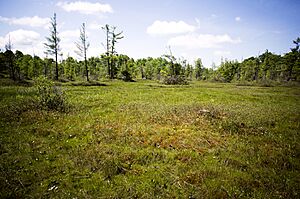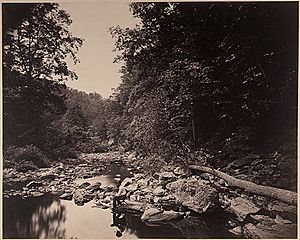List of National Natural Landmarks in Pennsylvania facts for kids
Pennsylvania is home to many incredible natural places, and some of the most special ones are called National Natural Landmarks. These are areas that have unique natural features, like rare plants, amazing rock formations, or important wildlife habitats. There are 27 of these special landmarks across Pennsylvania, each one protected to keep its natural beauty and scientific importance safe for everyone to enjoy.
Contents
- Bear Meadows Natural Area
- Box Huckleberry Site
- Cook Forest State Park
- Ferncliff Peninsula Natural Area
- Ferncliff Wildflower and Wildlife Preserve
- Florence Jones Reineman Wildlife Sanctuary
- Pine Creek Gorge
- Hawk Mountain Sanctuary
- Hearts Content Scenic Area
- Hemlocks Natural Area
- Hickory Run Boulder Field
- Lake Lacawac
- McConnells Mill State Park
- Monroe Border Fault
- Nay Aug Park Gorge and Waterfall
- Nottingham Park Serpentine Barrens
- Presque Isle State Park
- Reynolds Spring and Algerine Swamp Bogs
- The Glens Natural Area
- Snyder Middleswarth Natural Area
- Susquehanna Water Gaps
- Tamarack Swamp
- Tannersville Cranberry Bog
- John Heinz National Wildlife Refuge at Tinicum
- Tionesta Scenic and Research Natural Areas
- Titus and Wattsburg Bogs
- Wissahickon Valley
Bear Meadows Natural Area
Designated in 1965, Bear Meadows Natural Area is found in Centre County. It's part of the Rothrock State Forest and is a wonderful example of a natural wetland environment.
Box Huckleberry Site
This site in Perry County became a landmark in 1967. It protects a very rare colony of box huckleberry plants. What makes it so amazing is that this colony is over 1,000 years old! It's a small, 10-acre area within the Tuscarora State Forest.
Cook Forest State Park
Cook Forest State Park, designated in 1967, spans Clarion, Forest, and Jefferson counties. This 8,500-acre state park is famous for its incredible stands of old-growth Eastern White Pine and Eastern Hemlock trees. Many of these towering trees have been growing since around 1644!
Ferncliff Peninsula Natural Area
In Fayette County, the Ferncliff Peninsula Natural Area was recognized in 1973. This 100-acre peninsula is shaped by a big bend, called a meander, in the Youghiogheny River. It shows a great example of old forests in the Allegheny Mountains.
Ferncliff Wildflower and Wildlife Preserve
Designated in 1972, this preserve is located in Lancaster County. It's a private, nonprofit area. The plants here are a fantastic example of a mixed forest that grows in the valleys and ravines of the oak-chestnut forest region.
Florence Jones Reineman Wildlife Sanctuary
This sanctuary in Cumberland and Perry counties became a landmark in 1973. It's a large, 3,100-acre area with many different types of natural communities, making it a diverse home for wildlife.
Pine Creek Gorge
Known as the "Grand Canyon of Pennsylvania," Pine Creek Gorge was designated in 1968. It stretches across Tioga and Lycoming counties. This deep gorge was carved by glacial meltwater long ago. At its deepest, it's about 1,450 feet (442 meters) deep! It protects a huge area of 160,000 acres.
Hawk Mountain Sanctuary
Hawk Mountain Sanctuary, designated in 1965, is located on a ridge of the Blue Mountain in Berks and Schuylkill counties. It's a private, nonprofit sanctuary famous as an excellent spot to watch hawk migrations. Thousands of hawks fly past here each fall!
Hearts Content Scenic Area
This scenic area in Warren County was designated in 1973 or 1977. It's a 120-acre forest of very old white pine trees, part of the Allegheny National Forest.
Hemlocks Natural Area
Designated in 1972, this area in Perry County is part of the Tuscarora State Forest. It's special because it has many old-growth hemlock trees.
Hickory Run Boulder Field
Part of Hickory Run State Park in Carbon County, this boulder field was designated in 1967. It's a 16.5-acre landscape covered in sandstone boulders. These boulders were formed about 20,000 years ago, left behind by glaciers.
Lake Lacawac
Lake Lacawac in Wayne County became a landmark in 1968. This 52-acre glacial lake is surrounded by a forest of hardwood and conifer trees. It's a private, nonprofit preserve.
McConnells Mill State Park
Designated in 1972, McConnells Mill State Park in Lawrence County protects 2,546 acres of the Slippery Rock Creek gorge. The park is known for its beautiful waterfalls and rugged landscape.
Monroe Border Fault
The Monroe Border Fault in Bucks County was designated in 1980. It's an upland area along the Delaware River. This site is important because it shows many different types of rocks from various geological ages. It's part of Nockamixon State Park.
Nay Aug Park Gorge and Waterfall
Even in an urban park, nature can be amazing! This site in Lackawanna County was designated in 1989. Located in Nay Aug Park in Scranton, it features a beautiful, heavily wooded gorge with a waterfall and many rocks.
Nottingham Park Serpentine Barrens
Designated in 2009, this site is in Chester County. It's a 651-acre county park that sits on one of the largest areas of serpentine rock in the eastern United States. This special rock creates a unique, open savanna-like habitat where many unusual plants grow.
Presque Isle State Park
Presque Isle State Park in Erie County was designated in 1967. It's a 3,112-acre sandy peninsula that stretches out into Lake Erie. It's a popular spot for recreation and a vital habitat for birds and other wildlife.
Reynolds Spring and Algerine Swamp Bogs
Designated in 1974, these bogs are located in Tioga and Lycoming counties, within the Tioga State Forest. The site contains two bogs, one 1,302 acres and another 84 acres, surrounded by thick oak and pine forests. Bogs are special wetlands with unique plants.
The Glens Natural Area
Part of Ricketts Glen State Park, The Glens Natural Area was designated in 1968. It covers 2,845 acres in Columbia, Sullivan, and Luzerne counties. This area is known for its old-growth forest, where many trees are over 100 feet tall. It's also famous for its 22 named waterfalls!
Snyder Middleswarth Natural Area
Designated in 1967, this natural area in Snyder County is part of the Bald Eagle State Forest. It's a 500-acre forest with hemlock, pine, and oak trees.
Susquehanna Water Gaps
The Susquehanna Water Gaps, designated in 1968, are found in Cumberland, Dauphin, and Perry counties. Over millions of years, the Susquehanna River has cut through five ridges of the Appalachian Mountains north of Harrisburg. This created impressive landforms with unique geology and beautiful scenery.
Tamarack Swamp
Tamarack Swamp in Warren County was designated in 1977. It's an interesting natural area that features an acidic kettle pond bog. Bogs are wetlands that get most of their water from rainfall, making them very acidic.
Tannersville Cranberry Bog
Designated in 1974, the Tannersville Cranberry Bog is in Monroe County. This 1,000-acre area is a kettle lake fen. Fens are another type of wetland, but they get water from groundwater, making them less acidic than bogs.
John Heinz National Wildlife Refuge at Tinicum
Even in a big city like Philadelphia, nature thrives! This refuge, designated in 1965, spans Philadelphia and Delaware counties. It protects a 350-acre tidal marsh in an urban environment, providing a vital habitat for many species.
Tionesta Scenic and Research Natural Areas
Designated in 1973, these areas are in Warren and McKean counties, within the Allegheny National Forest. They protect 4,131 acres of old-growth forest on the Allegheny Plateau.
Titus and Wattsburg Bogs
These bogs in Erie County were designated in 1977. They form a 125-acre peatland located close to the shore of Lake Erie. Peatlands are wetlands where dead plant material accumulates, forming peat.
Wissahickon Valley
Designated in 1964, the Wissahickon Valley spans Montgomery and Philadelphia counties. It's part of Fort Washington State Park. This area protects an urbanized tributary of the Schuylkill River, featuring a beautiful gorge and thick woodlands right near the city.


